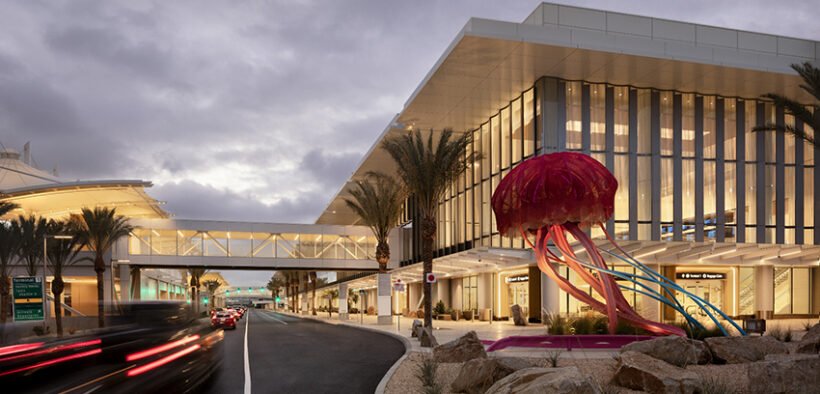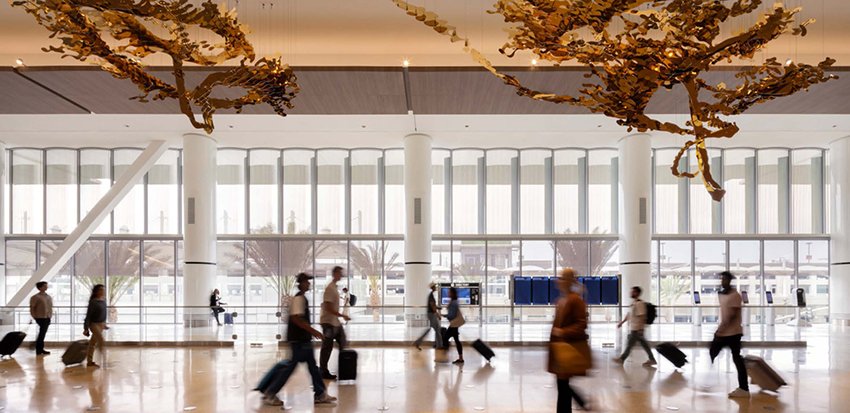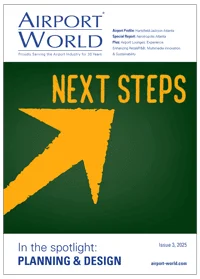Big, bold and beautiful
Share

San Diego International Airport’s new Terminal 1 was designed for the passenger experience, writes Terence Young, aviation leader, design director and principal at Gensler.
Throughout my architectural career I have designed airports around the world from LAX to Incheon, and over the years I’ve seen how the aviation industry responds to trends, with each new terminal capturing a snapshot of the airline industry at a specific moment in time.
However, the scale of an airport requires enormous investments of time and money, meaning the latest trends must be resilient over time, or we risk designing for obsolescence.
As a result, we must create structures that will work well for passengers now and in the future. We accomplish this through meaningful, human-centred designs that focus on a seamless passenger experience and provide flexibility for airports to evolve with the needs of passengers.
As global travel and passengers’ expectations change, airports are expected to serve not just as transit points, but as immersive environments that shape first impressions and imprint lasting memories.
The modern airport must balance operational efficiency with cultural expression, environmental responsibility, and technological
innovation. Couple this with the transformation of the United States’ aging airports, as outdated facilities receive billions of dollars in funding for updates via the US infrastructure bill.
Many operators are capitalising on this moment to rethink the passenger experience and how travellers engage with their city – from wheels down to wheels up.Gensler’s recent work with Turner-Flatiron on the redevelopment of Terminal 1 at San Diego International Airport (SAN) represents more than a capital improvement – it’s a transformation that reimagines the traveller experience at the nation’s busiest single-runway commercial airport.
The new terminal replaces the original 1960s-era structure with a facility nearly three times larger – expanding from 336,000 square feet to approximately 1 million square feet – and positions San Diego as a hub of innovation, connectivity, and sustainability for decades to come.
With 19 gates, 17 new food and retail concessions, 13 security lanes, and seven baggage carousels, the facility vastly expands SAN’s ability to better serve travellers. A second phase, scheduled for completion in early 2028, will add 11 additional gates.
ALL ROADS LEAD TO THE TERMINAL
We know that a successful airport design goes beyond the walls of the terminal and encompasses the journey to arrivals and departures. If that isn’t seamless, the passenger experience is off to a rocky start.
For Terminal 1, our team redesigned the roadway system to include 1.2 miles of new airport access roads, an elevated departures roadway, an extended arrivals kerb, and two new passenger bridges linking the terminal to a parking and transportation plaza.
The integration of new passenger processing eases congestion, which was a hallmark of the old T1 SAN experience, while introducing a ground transportation plaza, pedestrian-friendly pathways, and multi-use trails to integrate the terminal with the city, reinforcing its role as a civic and cultural gateway.
The result is a seamless drop-off and pick-up experience that reduces friction in getting travellers to their destination.

AIRPORT AS FRONT DOOR
More than just infrastructure, airports increasingly serve as cultural front doors that reflect the identity and aspirations of the city they serve. When we designed Terminal 1, we aimed to celebrate Southern California’s natural beauty by bringing in abundant daylight, allowing for expansive views from within and using local materials at every turn.
We prioritised a seamless, passenger-focused experience for all travellers, knowing that San Diego as a community is a diverse and welcoming population. In addition, we recognise that every passenger experiencing an airport is having a different experience.
From natural wayfinding to a variety of amenities, the design team provided a journey meant to reduce stress and maximise comfort, acknowledging neurodiversity and stresses which travellers often feel.
These guiding principles shaped every aspect of Terminal 1’s design, where architecture, art, and user experience converge to create a welcoming gateway to San Diego.
The curved, fritted glass panels of the 800ft long terminal façade is itself a piece of public art titled ‘Luminous Wave’ designed in collaboration with artist James Carpenter. The filtered sunlight illuminates the ticketing hall while reducing glare on monitors and wayfinding screens.
The structure’s braced columns minimise interior obstructions and provide conditioned air. The wave-inspired wood ceilings and acoustic treatments create a calming security experience and acknowledge San Diego’s distinct ties to the ocean.
The terminal celebrates the variety of the surrounding San Diego landscape through experiential design moments both large and small. An outdoor dining terrace with views of the San Diego skyline and Harbor Island provide a reprieve for passengers who traditionally have been relegated indoors once they pass through security.
WHERE PERFORMANCE MEETS PLACE
Terminal 1 is a cornerstone of SAN’s long-term airport campus transformation plan and aligns with the City of San Diego’s Climate Action Plan, advancing a vision for airports that are efficient, resilient, and deeply connected to the communities they serve.
The new terminal is pursuing LEED v4 Silver certification, Parksmart Gold for the parking plaza, and Envision v3 Silver for infrastructure performance.
It operates on 100% carbon-free electricity, supported by stormwater reuse systems, a 900,000-gallon underground cistern, and a roof designed to accommodate a 4MW solar array.
The terminal is projected to reduce total energy use by 20% and embodied carbon by more than 30%, with a structural lifespan exceeding 100 years.
San Diego’s Terminal 1 also reflects a growing industry trend: designing for the leisure traveller.
As business travel declines and discretionary travel surges, airports are adapting to longer dwell times and shifting expectations. Gensler’s design approach embraces this shift by curating environments that invite exploration, relaxation, and personalisation.
Terminal 1 signals a turning point for the aviation industry, proving that an airport can be both a high-performance engine and a reflection of its city’s character while setting a new standard for what travellers should expect worldwide. Airports are no longer judged only by how many planes they move, but by how well they move people — through experiences that restore calm, operations that cut carbon, and connections that drive regional economies.
As designers, we have the opportunity to shape not just how people move, but how they feel, while moving.
I believe the next generation of airports will be defined by empathy, adaptability, and a deep connection to place. By improving the passenger experience, we’re improving the flying experience.







